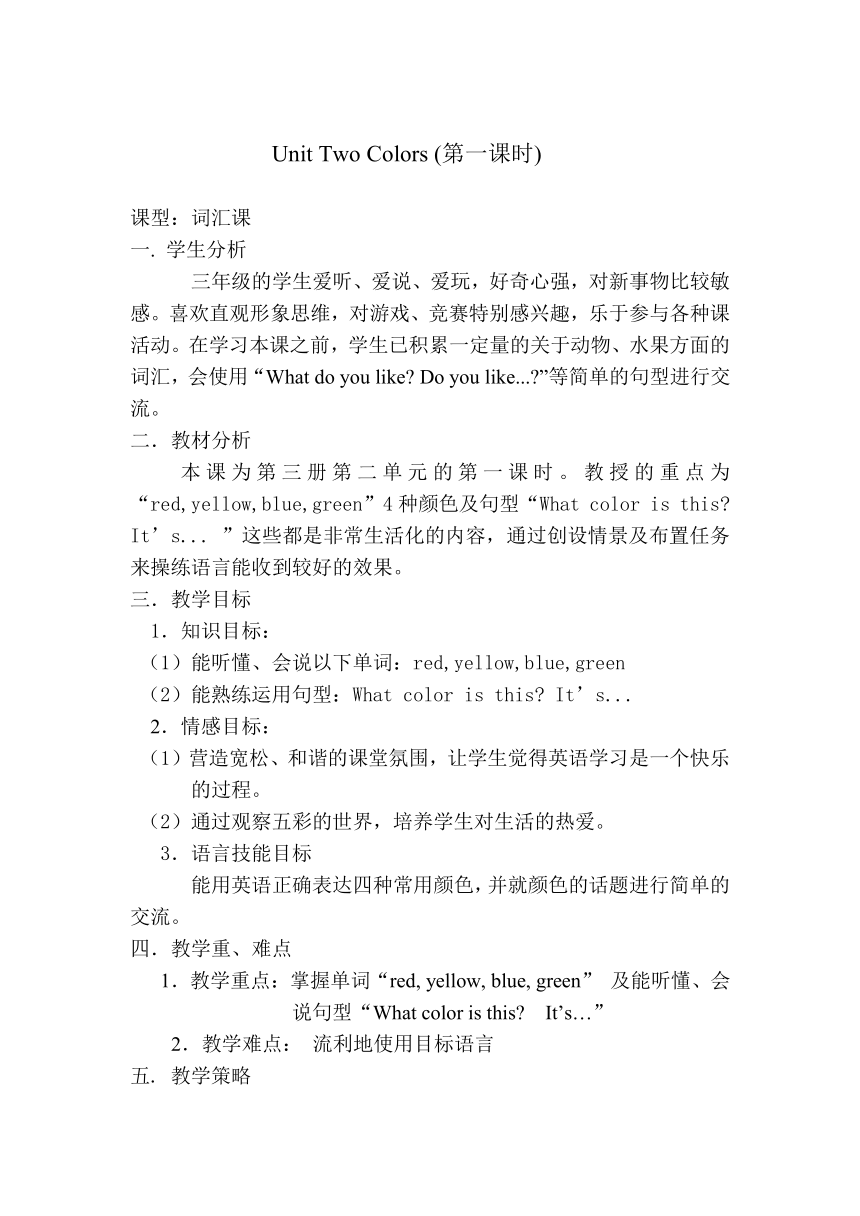Unit 2 Colors 第一课时教学设计
文档属性
| 名称 | Unit 2 Colors 第一课时教学设计 |

|
|
| 格式 | zip | ||
| 文件大小 | 2.1MB | ||
| 资源类型 | 教案 | ||
| 版本资源 | 广东版 | ||
| 科目 | 英语 | ||
| 更新时间 | 2017-09-04 21:20:42 | ||
图片预览


文档简介
Unit
Two
Colors
(第一课时)
课型:词汇课
学生分析
三年级的学生爱听、爱说、爱玩,好奇心强,对新事物比较敏感。喜欢直观形象思维,对游戏、竞赛特别感兴趣,乐于参与各种课活动。在学习本课之前,学生已积累一定量的关于动物、水果方面的词汇,会使用“What
do
you
like
Do
you
like... ”等简单的句型进行交流。
二.教材分析
本课为第三册第二单元的第一课时。教授的重点为“red,yellow,blue,green”4种颜色及句型“What
color
is
this
It’s...
”这些都是非常生活化的内容,通过创设情景及布置任务来操练语言能收到较好的效果。
三.教学目标
1.知识目标:
(1)能听懂、会说以下单词:red,yellow,blue,green
(2)能熟练运用句型:What
color
is
this
It’s...
2.情感目标:
(1)营造宽松、和谐的课堂氛围,让学生觉得英语学习是一个快乐的过程。
(2)通过观察五彩的世界,培养学生对生活的热爱。
3.语言技能目标
能用英语正确表达四种常用颜色,并就颜色的话题进行简单的交流。
四.教学重、难点
1.教学重点:掌握单词“red,
yellow,
blue,
green”
及能听懂、会说句型“What
color
is
this
It’s…”
2.教学难点:
流利地使用目标语言
五.
教学策略
根据任务型的学习理念,我采用了体验式与活动式相结合的教学方法,
积极创设语言环境,利用各种情景操练单词,句型.因为真实的语言环境方可实现语言的交际目的。在创设情景的同时,我还设计了大量有效的活动形式,让学生由始至终保持学习的热情和高度的参与性。
六.教学过程
Step
One
Warming
up。
(
A
finger
game.)
(有趣的手指游戏能让学生在蹦蹦跳跳中放松身心,感受英语魅力的同时保持高昂的情绪,避免了学生在紧张的心理状态下进入英语情景。)
Step
Two
Elicit
the
title
“Colors”
by
comparing
two
pictures.
One
is
colorful.
The
other
is
colorless.
(将黑白与彩色的图片对比呈现在学生面前,让学生直观感知多彩世界的美好。)
Step
Three
Present
the
new
words
by
a
magic
tree.
Then
get
the
kids
to
listen
and
show
the
corresponding
card.
(通过介绍神奇树上的各种水果,自然引出4种颜色,同时通过听单词、举色卡活动增加学生对单词的熟悉程度)
Step
Four
1.
Consolidate
the
pattern
and
the
words
by
three
guessing
game
1)Find
out
the
rule
of
the
chameleons.
(找规律的活动既巩固了学生对颜色的认知,又有效培养
了学生的观察能力与逻辑思维能力)
2)Guess
the
color
of
the
traffic
light.
(根据图片人物的反应猜测红灯或是绿灯,能在使用目标语言的过程中,渗透交通安全意识。)
3)
Guess
the
color
of
some
flags.
Like
the
flag
of
America,
the
flag
of
UK
,etc.
(该环节人人参与讨论,目标语言被一再运用,此外,谈论各国国旗的颜色,能能效地引起学生对外面世界的关注,这也给课外知识丰富的同学创造了一个展示的机会。)
2.
Color
the
flag
of
Olympic
Games
The
leader
of
each
group
should
close
the
eyes
and
turn
around.
The
rest
of
the
pupils
can
look
at
the
screen
for
5
seconds.
Then
each
leader
turn
around
,
ask
the
question
like
this:
“What
color
is
this ”
Get
the
information
from
their
teammates.
Then
color
the
flag.
(
《英语课程标准》指出英语课程要面向全体学生,关注每个学生的情感。涂色是学生喜闻乐见的一种形式,从他们的兴趣出发,设置信息差,使学生进一步熟悉新句型。)
Step
Five
1.
Read
the
story
and
find
out
the
answer.
“
What
color
did
Gogo
paint
first
What
color
did
he
use
then
At
last
what
color
did
he
use
(Put
the
cards
in
order)
2.Read
the
dialogue!
Expain
the
word
“many”
to
the
kids.
Then
ask
them
to
have
a
brainstorm:
many
books.
many
boys,
many
chairs...
(开放性问题的设计能活跃学生的思维,生成许多意想不到的精彩,使交际语言更加丰富、鲜活。开放性问题适合各层次的学生,成绩好的学生可在这里展示其丰富的词汇,学困生也能找到自己的表达方式。)
Step
Six
Extension.
1.
Make
a
funny
magic
tree!
Get
the
kids
to
make
group
and
color
the
fruit
on
the
tree
one
by
one.
Any
color
is
OK.
Make
a
funny
tree!
Make
a
tree
they
like!
When
they
are
coloring
,
the
following
sentences
should
be
used:
What
do
you
like
What
color
do
you
like
2.
Describe
the
magic
tree.
(小学生想象力丰富,喜欢天马行空的想象,设计“有趣的魔法树”一游戏能激发学生的学习兴趣,使他们在“玩”中掌握知识,促使学生从“要我学”向“我要学”转化,重视了教与学过程中学生的主观选择性。)
Step
Seven
Homework
Make
their
own
magic
tree.
Draw
the
fruit
they
like
,
color
them
and
write
down
the
dialogue
next
to
the
fruit.
板书设计:
Two
Colors
(第一课时)
课型:词汇课
学生分析
三年级的学生爱听、爱说、爱玩,好奇心强,对新事物比较敏感。喜欢直观形象思维,对游戏、竞赛特别感兴趣,乐于参与各种课活动。在学习本课之前,学生已积累一定量的关于动物、水果方面的词汇,会使用“What
do
you
like
Do
you
like... ”等简单的句型进行交流。
二.教材分析
本课为第三册第二单元的第一课时。教授的重点为“red,yellow,blue,green”4种颜色及句型“What
color
is
this
It’s...
”这些都是非常生活化的内容,通过创设情景及布置任务来操练语言能收到较好的效果。
三.教学目标
1.知识目标:
(1)能听懂、会说以下单词:red,yellow,blue,green
(2)能熟练运用句型:What
color
is
this
It’s...
2.情感目标:
(1)营造宽松、和谐的课堂氛围,让学生觉得英语学习是一个快乐的过程。
(2)通过观察五彩的世界,培养学生对生活的热爱。
3.语言技能目标
能用英语正确表达四种常用颜色,并就颜色的话题进行简单的交流。
四.教学重、难点
1.教学重点:掌握单词“red,
yellow,
blue,
green”
及能听懂、会说句型“What
color
is
this
It’s…”
2.教学难点:
流利地使用目标语言
五.
教学策略
根据任务型的学习理念,我采用了体验式与活动式相结合的教学方法,
积极创设语言环境,利用各种情景操练单词,句型.因为真实的语言环境方可实现语言的交际目的。在创设情景的同时,我还设计了大量有效的活动形式,让学生由始至终保持学习的热情和高度的参与性。
六.教学过程
Step
One
Warming
up。
(
A
finger
game.)
(有趣的手指游戏能让学生在蹦蹦跳跳中放松身心,感受英语魅力的同时保持高昂的情绪,避免了学生在紧张的心理状态下进入英语情景。)
Step
Two
Elicit
the
title
“Colors”
by
comparing
two
pictures.
One
is
colorful.
The
other
is
colorless.
(将黑白与彩色的图片对比呈现在学生面前,让学生直观感知多彩世界的美好。)
Step
Three
Present
the
new
words
by
a
magic
tree.
Then
get
the
kids
to
listen
and
show
the
corresponding
card.
(通过介绍神奇树上的各种水果,自然引出4种颜色,同时通过听单词、举色卡活动增加学生对单词的熟悉程度)
Step
Four
1.
Consolidate
the
pattern
and
the
words
by
three
guessing
game
1)Find
out
the
rule
of
the
chameleons.
(找规律的活动既巩固了学生对颜色的认知,又有效培养
了学生的观察能力与逻辑思维能力)
2)Guess
the
color
of
the
traffic
light.
(根据图片人物的反应猜测红灯或是绿灯,能在使用目标语言的过程中,渗透交通安全意识。)
3)
Guess
the
color
of
some
flags.
Like
the
flag
of
America,
the
flag
of
UK
,etc.
(该环节人人参与讨论,目标语言被一再运用,此外,谈论各国国旗的颜色,能能效地引起学生对外面世界的关注,这也给课外知识丰富的同学创造了一个展示的机会。)
2.
Color
the
flag
of
Olympic
Games
The
leader
of
each
group
should
close
the
eyes
and
turn
around.
The
rest
of
the
pupils
can
look
at
the
screen
for
5
seconds.
Then
each
leader
turn
around
,
ask
the
question
like
this:
“What
color
is
this ”
Get
the
information
from
their
teammates.
Then
color
the
flag.
(
《英语课程标准》指出英语课程要面向全体学生,关注每个学生的情感。涂色是学生喜闻乐见的一种形式,从他们的兴趣出发,设置信息差,使学生进一步熟悉新句型。)
Step
Five
1.
Read
the
story
and
find
out
the
answer.
“
What
color
did
Gogo
paint
first
What
color
did
he
use
then
At
last
what
color
did
he
use
(Put
the
cards
in
order)
2.Read
the
dialogue!
Expain
the
word
“many”
to
the
kids.
Then
ask
them
to
have
a
brainstorm:
many
books.
many
boys,
many
chairs...
(开放性问题的设计能活跃学生的思维,生成许多意想不到的精彩,使交际语言更加丰富、鲜活。开放性问题适合各层次的学生,成绩好的学生可在这里展示其丰富的词汇,学困生也能找到自己的表达方式。)
Step
Six
Extension.
1.
Make
a
funny
magic
tree!
Get
the
kids
to
make
group
and
color
the
fruit
on
the
tree
one
by
one.
Any
color
is
OK.
Make
a
funny
tree!
Make
a
tree
they
like!
When
they
are
coloring
,
the
following
sentences
should
be
used:
What
do
you
like
What
color
do
you
like
2.
Describe
the
magic
tree.
(小学生想象力丰富,喜欢天马行空的想象,设计“有趣的魔法树”一游戏能激发学生的学习兴趣,使他们在“玩”中掌握知识,促使学生从“要我学”向“我要学”转化,重视了教与学过程中学生的主观选择性。)
Step
Seven
Homework
Make
their
own
magic
tree.
Draw
the
fruit
they
like
,
color
them
and
write
down
the
dialogue
next
to
the
fruit.
板书设计:
